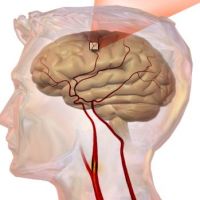The American Heart Association (AHA) has recommended the use of a stent retrieval device to remove blood clots in select stroke patients who have clots that obstruct the large arteries from supplying blood to the brain. This is the first time such a recommendation has been made by AHA and the update has been published in the journal Stroke.
Initial treatment for ischaemic stroke is the intravenous delivery of plasminogen activator (tPA). tPA, if given within a few hours after stroke symptoms, dissolves the clot and re-establishes blood flow to the brain.
However, William J. Powers, M.D., lead author of the focused update and H. Houston Merritt distinguished professor and chair of the department of neurology at the University of North Carolina at Chapel Hill explains that their analysis from six new clinical trials shows that patients could benefit from additional treatment with a stent retrieval device if a clot continues to obstruct one of the big vessels after tPA is given.
The blood clot is removed by puncturing an artery in the groin and threading a thin wire tube up into the brain until it reaches the blocked vessel in one of the large arteries. A stent retriever is pushed at the site of the blockage, into the clot and expands to grab it. The clot is then removed once the tube is pulled out. While tPA can be given by most doctors in the ER, stent retrieval is more difficult and requires a specialised centre or a healthcare facility that has specially trained people. The treatment must be done within six hours of the onset of stroke and the challenge is to get the patient to an appropriate hospital within that time frame.
The AHA recommends that patients should have their clots removed with a stent retriever if they:
- have no significant disability prior to the current stroke
- received tPA within 4.5 hours of symptom onset
- have a clot blocking a large artery
supplying blood to the brain
- are at least 18 years old
- had an acute, severe stroke
- have imaging showing more than half
of the brain on the side of the stroke is not permanently damaged
- can have the procedure start within
six hours after symptom onset
These recommendations are based on evidence that suggests the benefits of the treatment outweigh the potential risks in these patients. The guidelines are based on clinical trials and on average, patients who meet the criteria are expected to do better with the recommended treatment as compared to other strategies. The AHA update recommends the use of stent receivers as compared to other mechanical thrombectomy devices but does state that those other devices are reasonable for use in circumstances based on the physician’s clinical judgment.
The important thing to remember is that both tPA and clot-retrieval procedures work best if administered sooner than later. It is thus in the interest of the patient to remember the acronym F.A.S.T. (Face drooping or numbness on one side, Arm Weakness with inability to hold arms overhead, Speech Slurring and Time to call 911).
Source: American Heart Association
Image Credit: Wikimedia Commons
References:
William J. Powers, et.al. (2015) 2015 AHA/ASA Focused Update of the 2013 Guidelines for the Early Management of Patients with Acute Ischemic Stroke Regarding Endovascular Treatment: A Guideline for Healthcare Professionals from the American Heart Association/American Stroke Association. Stroke. DOI:10.1161/STR.0000000000000074



























